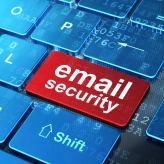 Everyone uses email as the central hub for their personal internet activities, but this also makes it an attractive target for cyberattacks. The importance of email security is vital to your company’s survival, so applying these simple tips can dramatically reduce your exposure to hackers and malware.
Everyone uses email as the central hub for their personal internet activities, but this also makes it an attractive target for cyberattacks. The importance of email security is vital to your company’s survival, so applying these simple tips can dramatically reduce your exposure to hackers and malware.
Use separate email accounts
Most people use a single email account for all their personal needs. As a result, information from websites, newsletters, shopping deals, and messages from work get sent to this one inbox. But what happens when someone breaks into it? There’s a good chance they would be able to gain access to everything else.
Having at least two separate email accounts will not only boost your security, but will also increase your productivity. You can have a personal account to communicate with your friends and family, while another is used solely for work-related communications.
Set strong passwords
Too many email accounts have predictable passwords. You might be surprised to learn that email passwords like “123456,” “qwerty,” and “password” are still the most common around. For the sake of security, set longer passwords (or passphrases) that contain a good mix of upper- and lowercase letters, numbers, and special characters. Make sure these passwords are unique to that account to keep all your other password-protected accounts safe.
You should also consider enabling multifactor authentication (MFA). This creates an extra layer of security by requesting for another method to verify your identity like a fingerprint scan or a temporary activation code sent to your mobile phone.
Beware of email scams
When you see a link in an email, don’t click on it unless you’ve assessed its authenticity. You never know where those links might lead you. Sometimes they can be safe, but other times they can infect your computer with malware.
If you’re expecting a file from your friend or family, then go ahead and open the attachment. It’s always good to know the person sending the file. But be wary of attachments in emails from strangers. Even if the file name looks like a JPEG image, you should never open it. Attached files may seem harmless, but they may actually be a malicious program ready to latch itself onto your computer the moment you click on it.
These types of attacks are known as phishing and they can be remarkably clever. For example, cybercriminals may masquerade as high-profile companies like Amazon, Facebook, or the Bank of America to catch their victims off guard. They might even create a sense of urgency by claiming that there’s an issue with your account, and that you should send them information or click on a dangerous link to “confirm” your personal details. Even if there was a genuine issue with your account, these companies would never ask something so suspicious over email. If you get these messages, contact the company directly through a verified website or phone number — not the contact details on the email.
Monitor account activity
Periodically watch over your account activity. Make sure to limit access privileges to apps if you want to ensure maximum privacy and security. Also, check for any suspicious activities in your logs like unusual devices and IP addresses that have accessed your account. This indicates that hackers may have successfully broken into your account. If this is the case, sign out of all web sessions and change your password as soon as possible.
Encrypt emails and update your software
Email encryption ensures that any message you send won’t be intercepted and viewed by unauthorized users. Meanwhile, installing the latest updates for your anti-malware, firewalls, and email security software filters potential email scams and fixes any vulnerabilities hackers can exploit.
Protecting your email accounts from various threats can be a daunting process, but with the right support, it should be effortless. Talk to us today for all your cybersecurity needs.

 Have you ever gotten frustrated with your smartphone because the web browser took more than five minutes to load? Before you start blaming your old phone, check out these four reasons that might be the cause of your slow internet connection.
Have you ever gotten frustrated with your smartphone because the web browser took more than five minutes to load? Before you start blaming your old phone, check out these four reasons that might be the cause of your slow internet connection.